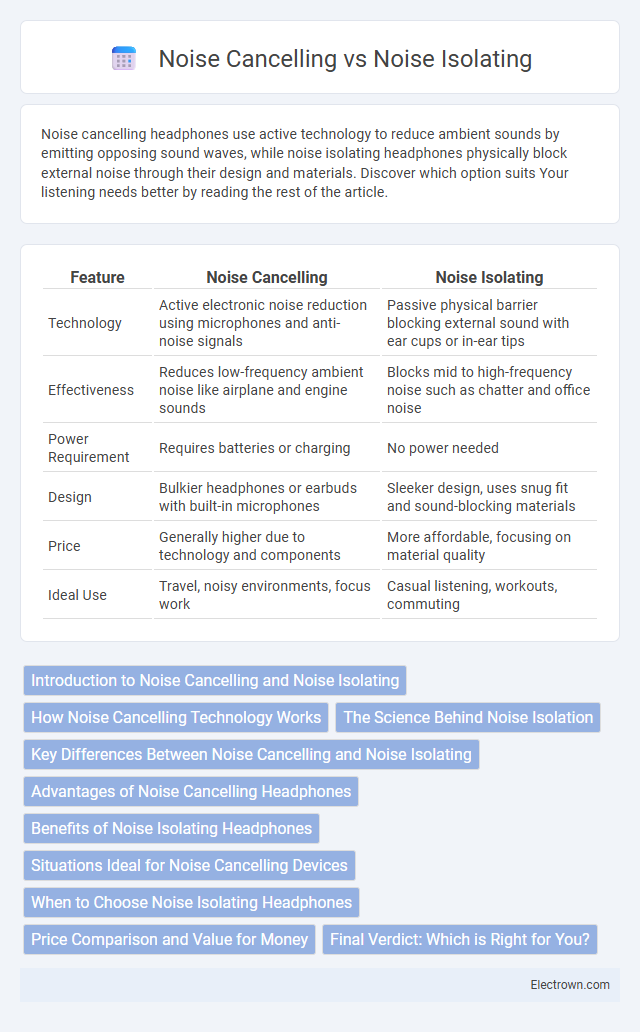Noise cancelling headphones use active technology to reduce ambient sounds by emitting opposing sound waves, while noise isolating headphones physically block external noise through their design and materials. Discover which option suits Your listening needs better by reading the rest of the article.
Table of Comparison
| Feature | Noise Cancelling | Noise Isolating |
|---|---|---|
| Technology | Active electronic noise reduction using microphones and anti-noise signals | Passive physical barrier blocking external sound with ear cups or in-ear tips |
| Effectiveness | Reduces low-frequency ambient noise like airplane and engine sounds | Blocks mid to high-frequency noise such as chatter and office noise |
| Power Requirement | Requires batteries or charging | No power needed |
| Design | Bulkier headphones or earbuds with built-in microphones | Sleeker design, uses snug fit and sound-blocking materials |
| Price | Generally higher due to technology and components | More affordable, focusing on material quality |
| Ideal Use | Travel, noisy environments, focus work | Casual listening, workouts, commuting |
Introduction to Noise Cancelling and Noise Isolating
Noise cancelling technology uses active electronic processing to reduce unwanted ambient sounds by generating inverse sound waves, enhancing your listening experience in noisy environments. Noise isolating relies on physical barriers like foam or silicone ear tips to block external noise, providing passive sound reduction without electronic components. Your choice depends on whether you prefer active sound control for dynamic noise or passive isolation for simple noise blocking.
How Noise Cancelling Technology Works
Noise cancelling technology uses microphones and advanced electronics to detect ambient sounds and generate sound waves that cancel out unwanted noise, creating a quieter listening environment. This active noise control contrasts with noise isolating, which relies on physical barriers like foam ear tips to block sound. Understanding how noise cancelling technology works can help you choose headphones that effectively reduce distractions for a more immersive audio experience.
The Science Behind Noise Isolation
Noise isolation relies on physical barriers such as ear tips and padding that create a seal in your ear canal, effectively blocking external sound waves from entering. The science behind noise isolation involves passive soundproofing that reduces ambient noise through material density and fit, without electronic processing. This method enhances your listening experience by minimizing interference, allowing you to focus on audio with fewer distractions.
Key Differences Between Noise Cancelling and Noise Isolating
Noise cancelling headphones use active technology with built-in microphones and electronic circuitry to detect and counteract ambient noise, effectively reducing low-frequency sounds like engine hums. Noise isolating headphones rely on passive physical barriers, such as snug-fitting ear cushions or ear tips, to block external sounds by creating a seal in or around the ear, primarily reducing mid to high-frequency noise. The key difference lies in the active electronic noise reduction of noise cancelling models versus the passive sound blocking approach of noise isolating designs.
Advantages of Noise Cancelling Headphones
Noise cancelling headphones use advanced microphones and electronic processing to actively reduce ambient sounds, providing a quieter listening experience ideal for noisy environments. They improve audio clarity by minimizing external noise interference, which enhances focus and prevents hearing damage from excessive volume. These headphones also offer greater comfort during extended use since users do not need to increase volume to block surrounding noise.
Benefits of Noise Isolating Headphones
Noise isolating headphones provide effective passive sound blocking by creating a physical barrier that reduces external noise, enhancing audio clarity without the need for power. They offer consistent performance for environments like commuting or office work where moderate noise reduction is sufficient. These headphones are typically more affordable, lightweight, and do not require batteries, making them convenient for long-duration use.
Situations Ideal for Noise Cancelling Devices
Noise cancelling devices excel in environments with consistent, low-frequency ambient sounds such as airplane cabins, busy offices, or public transportation, where their active technology reduces background noise effectively. These devices are ideal for your travel commutes or focused work sessions, allowing you to enjoy clearer audio and enhanced concentration. Noise cancelling headphones also perform well in noisy indoor settings, providing comfort and improved listening experiences during long periods of use.
When to Choose Noise Isolating Headphones
Noise isolating headphones are ideal when you need to block out ambient sounds without electronic interference, such as in quieter environments or while commuting. They rely on physical barriers like snug ear cushions or in-ear tips to create a seal, effectively reducing external noise passively. You should choose noise isolating headphones if you prefer a lightweight solution with longer battery life and a natural sound profile during focused activities.
Price Comparison and Value for Money
Noise cancelling headphones typically cost between $150 and $400, offering advanced active noise reduction technology that justifies their higher price, while noise isolating headphones are usually priced from $20 to $100 and rely on passive noise blocking through tight ear seal design. Despite higher upfront costs, noise cancelling models provide greater value for money for frequent travelers and office workers due to superior sound environment control and enhanced listening experience. Noise isolating headphones remain a budget-friendly option for casual users seeking basic noise reduction without the premium features of active cancellation.
Final Verdict: Which is Right for You?
Noise cancelling headphones use advanced microphones and circuitry to actively reduce ambient sounds, making them ideal for noisy environments like airplanes or busy offices. Noise isolating headphones rely on physical barriers and snug ear fits to block external noise, offering effective passive sound control without power or batteries. Choose noise cancelling for continuous, adaptive noise reduction and noise isolating for a simpler, often more affordable solution when complete silence isn't necessary.
noise cancelling vs noise isolating Infographic

 electrown.com
electrown.com